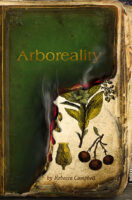 Arboreality
Arboreality
By Rebecca Campbell
Stelliform Press, Sept. 2022, 117 pp., ebook: $5.00, paperback: $15.00.
Rebecca Campbell says her novella Arboreality is a book about craftsmanship, and this is an apt description. Its story tells of epic feats of craftsmanship, from a man molding vast human habitats out of living trees to another painstakingly assembling one of the world’s finest violins. More broadly, the book is about societies at large crafting new identities for themselves and new ways of being in the world as the world we know today succumbs to the ravages of climate change. On both these levels, the book is a richly rewarding read.
It began as a short story titled “An Important Failure,” which appeared in Clarkesworld Science Fiction and Fantasy Magazine in August 2020 and won that year’s Theodore Sturgeon Memorial Award for best science fiction story. This initial story centers on the aforementioned luthier and his decades-long quest to turn a giant 500-year-old spruce tree into the perfect instrument for a young rising violin star. It is a tale of astonishing scope and power that brims with ideas and vital lessons for the present. Happily, the same can be said of all of its interconnected companion pieces in this book-length expansion.
Set in the future on Vancouver Island, Canada, Arboreality is made up of six parts that work as both stand-alone stories and chapters in a larger narrative. They are roughly chronologically arranged, and as their plots progress, so too does the inexorable march of civilizational decline. The world of the book’s early chapters is an all-too-plausible extension of today, marked by pandemics, climate migrations, deforestation, crumbling infrastructure and energy supply disruptions. By the later chapters, the suburbs have become archaeological sites; countless things we now take for granted—from pharmaceuticals to exotic fruits and vegetables from around the world—have become things of the past; and strange, exciting new symbioses are forming between humans and nature.
In the book’s opening piece, titled “Special Collections,” a university professor visits the campus library for the first time in many months and is shocked to find the building almost entirely abandoned and its roof badly leaking. The structure can’t be saved, and there isn’t enough time for the professor and the lone remaining librarian to relocate its entire contents. The professor and the librarian are thus forced to choose what to save and what to let go. Many of the books are close to extinction, so the loss of these copies might mean the permanent loss of the knowledge they contain.
It’s fascinating getting inside the professor’s head as he agonizes over his choices: “An oral history of west coast punk or a decent survey of the Second World War? […] The Bhagavad Gita or Journey Into the West or War and Peace?” Other choices are more cut and dried. Books on how to extract teeth and how to run a homestead should certainly be given priority, since future generations will need to know about these things. On the other hand, the microfiche reels are probably best left to the elements, since they will be unreadable once the age of electricity has dwindled away. And the centuries-old maps of Canada’s coastline, “ghostly and irrelevant” as they’ve now become, likely need not be saved either.
“Controlled Burn” is about a man gradually transforming his dying suburban neighborhood into a thriving forest garden. He’s a middle-aged man named Bernard. With his wife long since passed away and his daughter long since gone missing, Bernard finds solace in his gardening. One by one, his neighbors abandon their homes and leave town, driven away by drought, a deteriorating economy and vanishing public services. Bernard steadfastly remains, since his daughter wouldn’t know where to find him otherwise. We follow the slow exodus of the neighbors, and the equally slow advance of Bernard’s garden, over a period of years. The story is both mournful and enthralling as it shows the familiar trappings of today’s industrial lifestyles giving way to a new, much simpler, nature-based way of life.
I’ve already said a bit about “An Important Failure,” the award-winning short story that first sparked this novella. Apart from its human story, this piece is also a fascinating extrapolation of one of the lesser-known impacts of climate change: its threat to the sound of stringed music. In recent years there’s been growing concern about the stress climate change is placing on old-growth Sitka spruce, the tree whose wood is most prized for the construction of violins and other acoustic string instruments. This story takes place at a time when old-growth Sitkas are being wiped out by rampant wildfires. Younger Sitkas just aren’t the same. Because they grew up in a more carbon-heavy atmosphere, their wood is different and not well suited to instrument making. Thus our protagonist knows this violin may prove to be one of the very last violins as humanity has known them.
His quest to create something beautiful for future generations is tinged with melancholy. He feels remorse as he and his helpers easily fell the giant spruce; years later he’s still haunted by the sound it made as it came down, and wondering if it would still be standing if not for them. As he toils away in his workshop, he learns of tragedies occurring in the violin capital of the world, Cremona, Italy: floodwaters that kill thousands and destroy The Museo del Violino, home of the great works of Stradivari and Guarneri. Other fine instrument collections suffer the same fate. The story’s parting thought is that when the luthier’s violin is finally played, it will be “releasing the reverberations of a thousand thousand crimes and accidents into the singing air.”
In “Scions and Root Stocks,” we tour the disintegrating remains of a suburban street from the perspective of salvage-seekers scavenging the rubble for copper wire, catalytic converters, bricks, concrete and unbroken windows. Once everything of value has been extracted, the ruins will be burned away to make way for nature. Such is the fate of innumerable former suburbs in this future. Some sections are already so far gone they’ll likely be little changed by the fire; one character describes seeing only the shapes left behind by houses and yards. As we’re surveying this physical landscape, we’re also getting into the minds of our characters while they reflect on the obscene extravagance of the world that produced it: “bailey bridges and wind chargers and batteries and satellite networks in the sky overhead […] sucking all the sweetness from the world before [our protagonists were] even born.”
“Pub Food” is about the difficulty of treating physical illnesses in an era of decline. Our main character, Kaatza, is doing her best to provide comfort to a cancer-stricken man, which is challenging when pharmaceuticals are scarce, food supplies from the government are spotty, satellites are failing and a visit to the doctor is an arduous journey. This wistful piece aches for luxuries and good times now long passed. At one point Kaatza oddly finds herself hoping that Oregon’s Tillamook Creamery is still in operation: “[S]he had a largely unexamined hope that far to the south on the Oregon coast, kids were eating vanilla soft serve at Tillamook dairy.”
“The Cathedral Arboreal” returns us to the site of Bernard’s suburban forest garden decades after he first started coaxing it to life. The forest now stretches as far as the eye can see, and nothing remains of the suburb. We find ourselves in an agrarian society that seems to have transcended nationhood—the big plot point being the arrival of visitors whom our main characters refer to as “the Canadians.” A meeting of cultures takes place as the Canadians tell fabulous tales of life in the cities and the locals in turn share their natural ways. This final chapter takes its name from a genuine marvel of ecological architecture that is just now beginning to flower into its full potential: a cathedral entirely made of living trees.
I could rhapsodize a great deal more about the fine writing, emotional power and originality of Arboreality, but suffice to say that for connoisseurs of deindustrial fiction, it isn’t to be missed.
Teaser photo credit: By Mike Beauregard from Nunavut, Canada – Golden Spruce, CC BY 2.0, https://commons.wikimedia.org/w/index.php?curid=11131274






